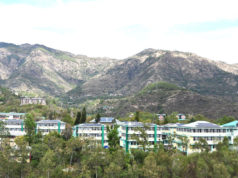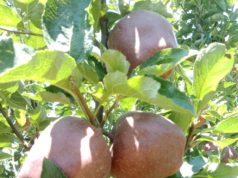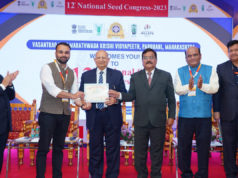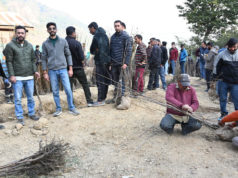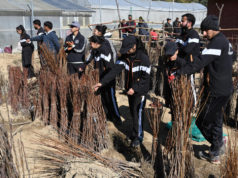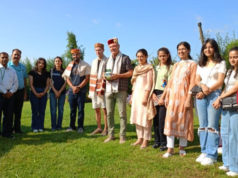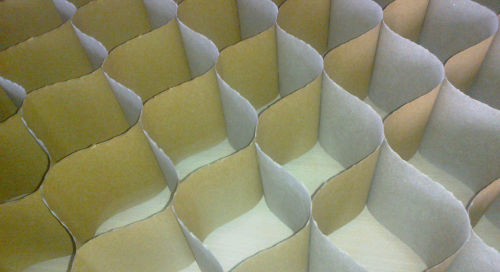Nauni/Solan: Due to the arrival of monsoon, there is an excess of moisture in the air due to which an outbreak of diseases in plants is witnessed. The problem of scab in apple, which was considered to be almost eliminated, was also seen in some areas of Himachal Pradesh last year. This year, incidents of scab disease have been reported from some areas of Kullu, Mandi and Shimla. Therefore, it is necessary to take measures to prevent the progression of the disease. Dr YS Parmar University of Horticulture and Forestry (UHF), Nauni has issued an advisory to farmers for the effective management of apple scab, premature leaf fall and Alternaria leaf fall. The following advisory must be followed by the orchardists to effectively manage the diseases.
Nauni University advisory for Mid-hills
The sprays of propineb @ 0.3% (600gm / 200L water) or dodine @ 0.075% (150gm / 200L water) or metiram 55% + pyraclostrobin 5% WG @ 0.150% (300gm / 200L water) or tebuconazole 8% + captan 32% SC @ 0.25% (500ml / 200L water) are recommended for the management of apple scab.
Metiram 55% + pyraclostrobin 5% WG @ 0.150% (300gm / 200L water) or fluxapyroxad + pyraclostrobin 500 SC @ 0.01% (20ml / 200L water) are recommended for the management of premature leaf fall and Alternaria leaf spot in apple.
Nauni University advisory for low hills
The sprays of propineb @ 0.3% (600gm / 200L water) is recommended for the management of apple scab, while tebuconazole 50% + trifloxystrobin 25% WG @ 0.04% (80gm / 200L water) is recommended for the management of premature leaf fall.
20-25 days before harvest, the sprays of metiram 55% + pyraclostrobin 5% WG @ 0.1% (200gm / 200 L water) is recommended for the management of apple scab and Alternaria leaf spot.
The university has advised the farmers to strictly follow the spray schedule recommended by the university and the horticulture department and take all safety precautions while undertaking spray.
Dr Parvinder Kaushal, Vice-Chancellor of the University said that the university is alert about the whole situation and it has been ensured that the scientists working in the University departments, Krishi Vigyan Kendras and Regional Research Stations located in the areas from where such incidents have been reported are providing scientific inputs to control the problem. The scientists are also visiting the orchards. He added that the university is very cautious towards this situation so that the farmers do not suffer losses.
What is Apple Scab?
Apple scab is caused by the fungus, Venturia inaequalis. The fungus overwinters mainly in the infected fallen leaves on the orchard floor through the formation of pseudothecia, which produce ascospores in the spring. After deposition on leaf or fruit surface, the ascospores germinate in a film of moisture.
The minimum wet period needed for infection is 9 hrs at 17oC. Once the infection has occurred, the fungus produces conidiophores and conidia. Sporulating lesions become visible approximately 9-17 days after infection depending upon the temperature, leaf wetness and relative humidity. The minimum relative humidity needed for sporulation to occur is between 60-70%. Upon sporulation, conidia are dispersed to leaf and fruit tissue by wind and splashing rain.
Scab symptoms are observed on leaves, petioles, fruits and twigs. The symptoms appear in the spring as small dull olive-green patches on the young emerging leaves and sometimes only on the underside. As the disease progresses, darker spots develop on both surfaces of the leaves. Young lesions are velvety, brown to olive green or mousy black having feathery and indistinct margins. Later, these lesions coalesce and the tissues surrounding them thicken and the leaf surface is deformed, curled and distorted. Sometimes, the entire leaf surface gets covered with scab lesions. Such infected leaves turn yellow and may fall prematurely. Small superficial lesions or large patches develop on the fruit surface usually at the calyx end. The severe early infection results in the formation of misshapen fruits and serious cracking while shrivelling often occurs. The lesions on the twig are small, 3–5 mm long, slightly raised and reddish-brown spots which later develop as blisters and cause bursting of bark.


